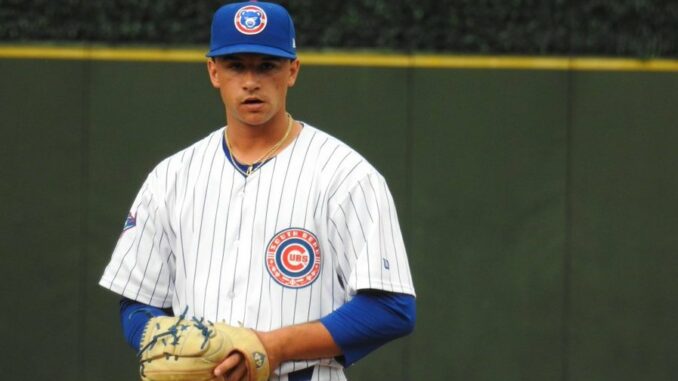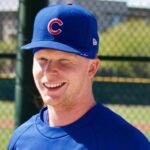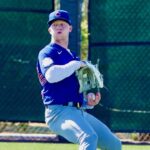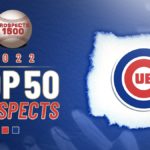
The Cubs’ inability to develop pitching was well-known during the first six years of Theo Epstein’s tenure. They failed miserably. While it’s true that the Cubs basically had no developmental philosophy when Theo took over, the “Cubs Way” he had implemented upon arriving hadn’t done much to develop major league caliber pitching prospects. Theo was attempting to zig while the rest of the league zagged by selecting arms without elite velo but with plus curveballs, changeups, and sound and repeatable deliveries in an effort to avoid losing developmental time due to injuries. The Cubs may have avoided injury to their pitching prospects, but they wound up with a bunch of arms that never developed beyond back-of-the-rotation types. If they hadn’t struck gold with the Jake Arrieta trade, 2016 probably never happens.
Much to Theo and Jed Hoyer’s credit, they acknowledged publicly that their draft philosophy for pitching wasn’t working and their pitching development infrastructure needed a complete bottom-up overhaul. Starting in 2018, they changed their draft philosophy and in January of 2019 hired Craig Breslow to lead the overhaul. Breslow spent the 2019 season evaluating the developmental infrastructure and suggested upgrades to the Cubs front office. They immediately implemented the changes and by 2020 the new system was in place, though untested.
Well, it’s now been tested. Here’s a look at the development of pitchers at Single-A Myrtle Beach this season.
RHP Luis Devers (22) 6’3″ 180 lbs.
1st 7 starts: 24.1 IP, 25 K, 9 BB, 3.70 ERA, 1.36 WHIP
Last 13 starts: 63.2 IP, 65 K, 8 BB, 1.41 ERA, 0.82 WHIP
VIDEO: #Cubs RHP Prospect Luis Devers Shuts Down Hitters! Highlights from 3.0 shutout relief innings on July 6th and a 6.0 inning no-hit start on July 23rd for the @SBCubs! pic.twitter.com/FtgLZdgdqj
— Inside the Ivy (@InsidetheIvy) July 26, 2022
RHP Porter Hodge (21) 6’4″ 230 lbs.
First 7 starts: 29.1 IP, 34 K, 14 BB, 3.68 ERA, 1.33 WHIP
Last 12 starts: 49.1 IP, 70 K, 28 BB, 2.19 ERA, .199 BAA
Porter Hodge’s night is done and it was quite the performance.
5 IP, 2 H, 0 R, 3 BB, 6 K
Here’s all 6 punchies (and I’m missing some serious swords in early counts) pic.twitter.com/Uy5bMvm3El
— Greg Huss (@OutOfTheVines) April 30, 2022
RHP Tyler Schlaffer (21) 6’1″, 180 lbs.
First 11 starts: 40.1 IP, 42 K, 19 BB, 5.13 ERA, 1.26 WHIP
Last 8 starts: 40 IP, 44 K, 14 BB, 2.48 ERA, 0.98 WHIP
Client @TylerSchlaffer highlight reel as he gets the “W” tonight going 6 strong innings allowing 1ER, 1BB and striking out 4!! #t #getsthew #cubs #onemission #onefamily #oneprimetime pic.twitter.com/mp7Y5p66lm
— Primetime Sports Group (@PTSportsGroup) August 19, 2021
LHP Luke Little (21) 6’8″, 220 lbs.
First 6 starts: 13.2 IP, 23 K, 9 BB, 4.61 ERA, 1.54 WHIP
Last 12 starts: 33.1 IP, 52 K, 19 BB, 1.62 ERA, .151 BAAj
Luke Little’s 4th K of the night with a little K skip at the end! pic.twitter.com/IOMtzckKSr
— Jordan Miller (@Miller_MiLB) August 3, 2022
Devers, Hodge and Schlaffer have been given promotions to High-A South Bend, and Little can’t be too far behind. And that’s just at one level. Jordan Wicks and DJ Herz similarly developed at and eventually dominated High-A and have earned promotions to AA. It’s taken two years, but it finally seems like the Cubs have the talent in their system and the developmental infrastructure to consistently produce a pipeline of pitching to the major leagues. So how did they get there?
Starting in 2018, the Cubs finally started drafting more upside HS arms and high velocity arms instead of prioritizing college arms with plus curveballs and present control.
2018 – Kohl Franklin (6th round), Riley Thompson (11th), Cam Sanders (12th)
2019 – Ryan Jensen (1st round), Michael McAvene (3rd), DJ Herz (8th), Tyler Schlaffer (9th), Porter Hodge (13th)
In 2020, Dan Kantrovitz came on to oversee the draft. Since then, the drafting of upside arms has seen an uptick.
2020 – Burl Carraway (2nd round), Luke Little (4th), Koen Moreno (5th), Ben Leeper (UDFA)
2021 – Jordan Wicks (1st), Drew Gray (3rd), Zac Leigh (16th)
As is common with pitching prospects, not all of those named have flourished. Carraway has been a complete bust thus far. Jensen has struggled. Franklin, Thompson, McAvene, Moreno, and Gray have missed time due to injury. But Sanders is primed to join the major league bullpen soon with Leeper and Leigh not that far behind him. Herz, Schlaffer, and Hodge have surpassed expectations. Little has dominated Single-A, while Wicks, who is likely to make his MLB debut sometime next season, has become what most thought he would when he was drafted 21st overall, a solid middle-of-the-rotation prospect who has progressed quickly through the Cubs system.
That brings us to the 2022 Cubs draft which saw at least 5 upside/high velocity arms (Cade Horton, Jackson Ferris, Nazier Mulé, Brandon Birdsell and Luis Rujano) join the Cubs organization. Plus, there are 3-4 more arms that have mid-to-upper 90s velo but are rawer than the others. When you combine the growing number of upside arms with a successful pitching development infrastructure, the Cubs finally have a shot at developing top-of-the-rotation prospects. That is something fans on the north side haven’t been able to say for a long time.
What was once derided as a failure, a joke, and one of the reasons why the Cubs chose to rebuild, is now a beacon of hope for sustained success. The Cubs have DJ Herz and Jordan Wicks in AA. Trade addition Caleb Kilian in AAA along with homegrown arms Keegan Thompson, Justin Steele, Brandon Hughes, Erich Uelmen and Adbert Alzolay in the majors. The entire South Bend rotation is stacked. Luke Little has very intriguing upside in Myrtle Beach, power arm relievers populate all 4 levels and with Drew Gray returning from TJS and Cade Horton, Jackson Ferris, Nazier Mulé, Brandon Birdsell, Luis Rujano, and 4-5 more upside arms incoming from this year’s draft, the Cubs may finally have the steady pipeline of pitching needed to create an elongated championship window.
I've been analyzing the Cubs minor league system for over 30 years and commenting on it since 2003. When I'm not doing that, I'm trying to be the best dad I can be for my 2 daughters and acting in TV shows and commercials in Los Angeles.




Leave a Reply